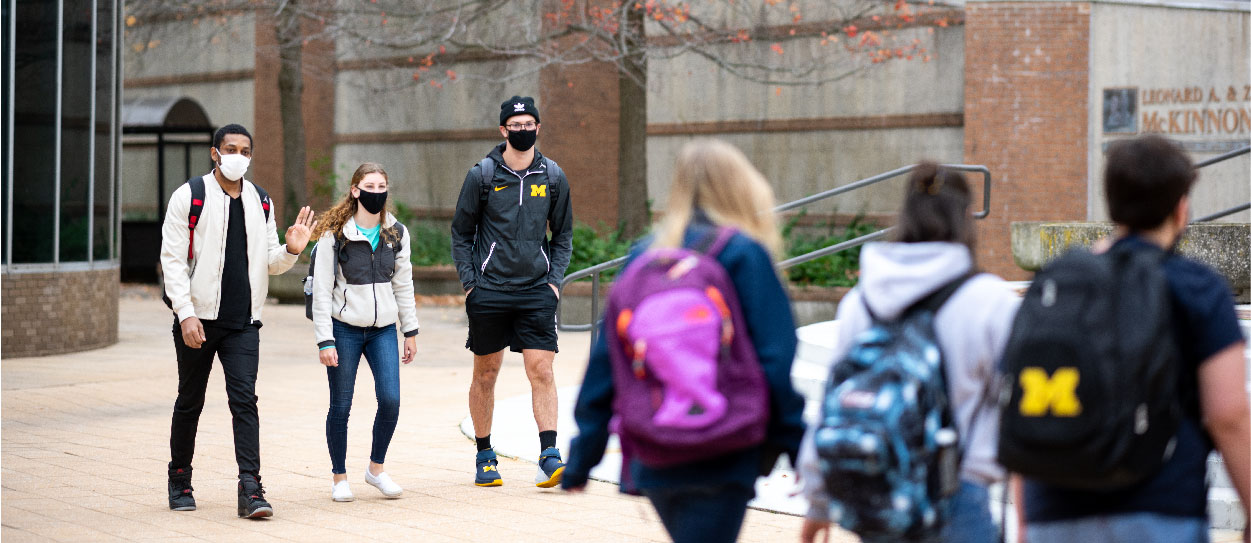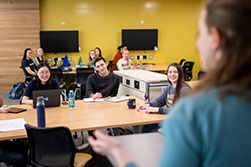
As the fall term begins, instructors and students are returning to campus in ways that will be both familiar and unique. While a very high percentage of classes will be offered in person (over 97% in LSA), we continue to grapple with the delta variant of the coronavirus, and masks will be mandatory for everyone in classrooms across U-M. For many continuing students, and for those just starting their first year (including instructors), Fall 2021 will be their first experience with in-person teaching and learning since March 2020. While first- and second-year students will have no experience with fully in-person classes, even juniors will have had only one fully uninterrupted semester.
At the same time, we have heard from instructors that remote teaching led them to new insights and improved practices, which they plan to maintain in the in-person setting. This blog is designed to bring together insights from U-M students and instructors, as well as national and U-M resources for navigating the unique circumstances of this term. Together they offer a range of ideas you can choose from based on the specifics of your class, your students, and your teaching style. CRLT consultants are glad to meet with you about any aspect of your teaching. We will hold daily office hours via Zoom, and you can sign up for an individual consultation on the CRLT website.
Teaching and learning effectively while masked
- LSA Technology Services has developed this very helpful list of Tricks and Tips for Teaching with Masks.
- As of August 24, 91% of U-M students reported being vaccinated, indicating a very high level of compliance with the university’s mandates. It is reasonable to expect that students will be similarly compliant with mask mandates. If you see a student not wearing a mask, it is best to begin with a polite reminder of the policy. In the unlikely event that a student refuses to comply after being reminded politely, instructors can ask the student to leave the class. If the student refuses, the instructor can leave and cancel class. Please note that these steps should be taken only as a last resort, and instructors should report to their department, school, or college if a case such as this does arise.
Maintain flexibility and empathy with students
Across modalities and class types, students reported appreciating instructor flexibility over the past 18 months. While the specifics of the situation have shifted, flexibility remains a key principle of effective and equitable teaching, especially at a time when students might face continued health concerns for themselves or their families. Suggestions for areas of flexibility include the following:
- Move away from rigid course policies (such as grade penalties for all absences and assignment deadlines with no exceptions). In general, consider focusing on performance rather than attendance and be willing to revisit policies based on circumstances arising for students. In addition, consider making contingency plans should students need to miss class for an extended period (e.g., for quarantining, illness, etc.), and talk to students proactively about those plans. For example, how might they access materials, make up assignments, continue to participate, etc.? Consider including this information on your syllabus as well.
- Attend to accessibility and actively invite accommodation requests: For various reasons, students might not always choose to disclose accommodation needs right at the beginning of the term. If you let students know the kinds of pedagogies and learning activities you have planned, it can help them determine whether they are likely to require accommodations in your course. Use this link to see SSD’s suggested syllabus statement (scroll to bottom of page), to review other important information, and to learn about the new Accommodate system that will notify you of student accommodations you will need to implement. You might also consider running UDOIT, an accessibility auditing tool that scans your Canvas course, generates a report of accessibility issues that could impede your students' ability to learn, and provides resources for addressing these issues.
Check in with students early and often
National data from all levels of education indicate that student learning was negatively affected by the pandemic (see this article for a good summary of those data). As a result, your students may not arrive in your classroom with the same sets of skills and knowledge as in past years. In addition, students will be bringing a unique set of hopes and anxieties to this term. Given this reality, it may be helpful to do initial surveys of students to gauge their level of comfort and preparedness for your course, which might be quite different from past semesters. Here are some possible approaches:
- Survey students before or at the start of the term about their attitudes, including topics such as their comfort being in a physical classroom, their comfort working with colleagues in groups, and what they are excited about, as well as what they consider to be potential obstacles for them this term.
- Distribute an anonymous “background knowledge probe” early in the semester and use the results to adjust your expectations as well your course content. At the simplest level, this can take the form of a series of multiple choice questions listing course topics and asking students to indicate their familiarity/depth of knowledge with that topic: How familiar are you with a “t-test”?
- I have never heard of it.
- I have heard of it, but don’t remember what it is.
- I have some idea of what it is, but am not too clear.
- I know what it is and could explain what it’s for.
- I know what it is and when to use it and could use it to analyze data.
- Ask students to complete minute papers and muddiest point activities regularly to check on their understanding (visit this CRLT page for descriptions of both strategies). You can also survey students early in the semester about what’s promoting their learning and what isn’t. CRLT consultants can work with you on a range of approaches to midterm student feedback.
Be aware of successful strategies from the last 18 months
- Foster connections with and among students: In an effort to decrease the anonymity of computer-mediated classes, instructors across U-M took additional steps to connect with their students over the past 18 months. And in surveys about remote teaching, students appreciated those efforts. One strategy is to take time early in the term to introduce yourself (either in class or in a recorded video posted to Canvas). This could include a discussion of your own work and academic interests and, if you are comfortable doing so, including something about your personal life, (such as your interests, family, or path into your discipline), as well as a message about how to succeed in the course. You can ask students to do similar introductions with each other to foster a sense of community in the classroom. Using apps like Piazza for crowdsourcing questions and answers, or study groups through Canvas Groups, can also help build community. Additionally, consider reaching out to students who have missed assignments or received a poor grade to offer support, and message students who did well to congratulate them.
- Learn and use student names (and pronounce them correctly) and their pronouns: In a Zoom world, instructors appreciated seeing student names and pronouns on screen, and students report feeling a greater sense of belonging when instructors know them by name. One strategy to recreate the Zoom name label is to ask students to make and display name tents in class. The roster function in the Wolverine Access Faculty Center includes the ability to see and print a photo roster of students, and this site offers a range of strategies for learning student names. New this year, U-M instructors and students have access to NameCoach a web-based tool integrated with Canvas that allows students to record their names to facilitate correct pronunciation.
- Leverage online office hours: In surveys and course evaluations over the past three terms, students indicated that online office hours were a particularly convenient and effective way for them to connect with instructors and get help with course material. In smaller classes, consider proactively setting up office hour appointments with students early in the term. In larger courses, this can be done by GSIs leading sections. You could also consider group online office hours to handle common questions about course content and promote student collaboration.
- Consider providing access to videotaped lectures: Lecture video enabled students to adjust the pace at which they engaged course material and facilitated their ability to review when needed. This can be accomplished through lecture capture of live lectures, use of MiVideo to capture and record using PowerPoint, and even the use of the recording function in Zoom. You could also post lectures (or lecture excerpts) from previous terms as study guides, or create short videos to address common questions or challenges students are facing. Another approach is to use a "flipped classroom" model, in which lectures are recorded for students to watch at home, and class time is used for active learning.
- Intentionally promote growth mindset: There is considerable evidence about the positive impact on student learning of conveying a growth mindset (i.e., emphasizing that positive performance results from effort and intentional strategies to learn from failure rather than from innate ability). This can be done by sharing your own stories or the stories of those in your field who encountered and overcame academic difficulties, providing mechanisms to get feedback on work in progress, or even using "exam wrappers" for encouraging students to reflect on wrong answers and use that knowledge to improve.
- Move away from infrequent, high-stakes exams: During remote teaching, the use of high stakes, multiple choice exams focused on factual information was not feasible. As a result, U-M instructors developed a range of strategies for testing that actually align with best practices, especially around decreasing student stress and anxiety and focusing on significant learning. Such strategies include the use of more frequent, lower-stakes assessments rather than one or two exams that make up a substantial portion of the final grade; a focus on higher-level thinking skills rather than recall of factual information (even for multiple-choice questions); use of open-book, open-note exams; building in room for recovery for students who do not do well; and offering multiple modes of engagement for participation grades (e.g., discussion boards, small-group interactions in addition to full-class discussion, in-class writing activities to process learning and prepare for larger discussions).
Attend to student wellbeing and mental health - and your own
The pandemic, the effects of racialized violence, and the ongoing political turmoil in the US and internationally have led to higher levels of stress for students and a concomitant increase in mental health concerns and calls for greater support for students. For example, results of a recent survey of over 35,000 incoming college students reveal that 53% percent reported a substantial increase in mental and emotional exhaustion, 70% indicated "high expectations of academic difficulty," and about 30% reported increased depression and greater loneliness. The report concluded that these data suggest an imperative to implement widespread and early check-ins and interventions by faculty and staff to help students succeed. This CRLT Occasional Paper contains advice about supporting students facing mental health challenges. Specific strategies include the following:
- Explicitly promote self-care and wellness throughout the semester.
- Normalize academic effort and struggle.
- Be attentive to changes in student behavior.
- Make students aware of resources: While instructors should take great care not to try to diagnose students’ mental health and should never require students to seek support or health care, they often serve as an important point of connection to the University for students who are facing mental health challenges. It is appropriate to your role to express concern about students’ well-being and make sure students are aware of a range of resources and support available to them. This U-M page lists campus stress and mental health resources.
- Include language on mental health support in your syllabus: As part of its work to support student well-being, the Health and Wellness Collective Impact for Student Life has developed this sample statement that instructors can include in their syllabi: “Students may experience stressors that can impact both their academic experience and their personal well-being. These may include academic pressure and challenges associated with relationships, mental health, alcohol or other drugs, identities, finances, etc. If you are experiencing concerns, seeking help is a courageous thing to do for yourself and those who care about you. If the source of your stressors is academic, please contact me so that we can find solutions together. For personal concerns, U-M offers the following resources [for the full list of resources, visit https://studentlife.umich.edu/syllabus-statement-well-being].”
- As you consider your teaching this term, we encourage you to make time to take care of yourself. We know from multiple national surveys, as well as discussions with instructors at all levels, about the heightened levels of stress associated with navigating the past 20 months. Similar to students, instructors have faced a combination of juggling professional responsibilities, including new modes of teaching, combined with lack of childcare, concerns about the health and well being of themselves and those close to them, and anxiety around ongoing political crises and acts of racial injustice. Research indicates that these challenges have been particularly severe for women and instructors of color. We encourage you to take advantage of U-M resources to support instructor wellbeing, including the Faculty and Staff Counseling and Consultation Office (FASCCO)which provides confidential and professional counseling.
- Log in to post comments
- 879 views






